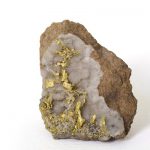 When selling jewelry, you want to present your wares in the best light – literally. Depending on the type, cut, and quality, gemstones can look differently in particular types of lighting. Alloys behave similarly (in fact, the exact way specific metals reflect light is what we measure in an X-RF assay). To convey the true beauty of your products, it helps to understand the basics of selecting a light source: brightness, color temperature, and color rendering index (CRI)
When selling jewelry, you want to present your wares in the best light – literally. Depending on the type, cut, and quality, gemstones can look differently in particular types of lighting. Alloys behave similarly (in fact, the exact way specific metals reflect light is what we measure in an X-RF assay). To convey the true beauty of your products, it helps to understand the basics of selecting a light source: brightness, color temperature, and color rendering index (CRI)
Most common lightbulbs and lamps have a brightness equivalent to either 40-watts or 60-watts. Sixty-watt lights are bright enough for open spaces and entire rooms, but can cause undesirable glare or reflections in displays. For these more intimate areas, lights closer to 40-watts of brightness provide adequate, but not overpowering, illumination.
Color temperature is measured on the Kelvin (K) scale. Lower Kelvin numbers mean that the light appears more yellow; higher Kelvin numbers mean the light is whiter or bluer. Most light sources are grouped into one of three ranges on the Kelvin scale:
- 2200K-3000K – yellow range (usually advertised as “soft white” or “warm white”)
- 3500K-4100K – bright white range (usually advertised as “white” or “cool white”)
- 5000K-6500K – blue-white range (usually advertised as “daylight”)
The “best” color temperature really depends on what is being illuminated. Lower color temperatures look “warmer” and can be used to make an area feel more relaxing or inviting for shoppers – or to accentuate the tones of yellow or orange gems and gold jewelry. Since medium color temperatures are more in the neutral/white range, they’re a good choice for general-purpose lighting. The blueish-white temperature range is great for drawing attention to intricate details or imparting a dynamic energy to special displays.
Color rendering index is an indicator of how accurate colors will look under the light, as well as how well subtle variations in color shades are represented. A CRI of 100 represents the maximum value and the most faithful representation of colors. Most fluorescent lights have a CRI between 50 and 70, so they are not well suited for displays. Most LED light bulbs (and some CFL bulbs) fall in the 80-90 range, which appears as perfectly accurate to all but the most eagle-eyed individuals.











